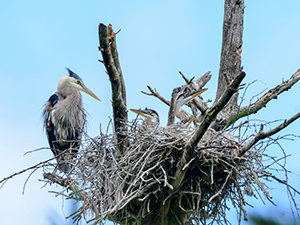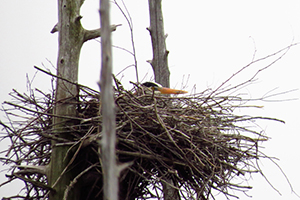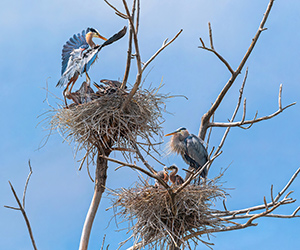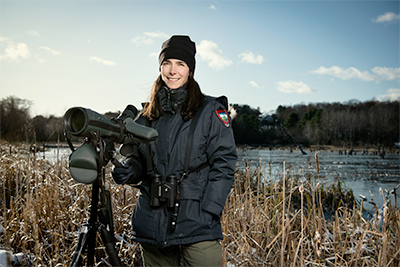Home → Fish & Wildlife → Citizen Science Projects → Maine Heron Observation Network
Maine Heron Observation Network

The Heron Observation Network of Maine is a community science adopt-a-colony program in which volunteers monitor great blue heron colonies throughout the state and record information regarding the number of active nests each spring.
Maine Department of Inland Fisheries and Wildlife (MDIFW) started the project in 2009 to help investigate the status of Maine’s nesting population of great blue herons. Since 1983, the coastal breeding population of great blue herons has undergone an 82% decline; and it is unknown whether that decline is a statewide phenomenon or whether it is restricted to only the coastal colonies. This is where HERON volunteers come in: they collect invaluable data on colonies statewide that will help biologists assess the population trend over time.

By “adopting” a colony, a volunteer agrees to visit the site at least once during the breeding season (May-July) and report back to MDIFW whether or not it was active and the number of active and inactive nests. Observations are made from a distance and only if disturbance to the nesting birds can be avoided. If the volunteers are willing to commit additional time, they can visit as often as every other week to track individual nests and report the number of young that hatch and fledge. These data can be used to better understand productivity and nest success rates, which may in turn affect the adult breeding population trend over time.
Since its inception, 200 HERON volunteers have provided data on 216 colonies statewide. These data have helped MDIFW better understand the dynamic nature of great blue heron nesting habits, and have led to additional research aimed at identifying sources of disturbance and developing an optimal way to estimate the statewide population.
Report a Colony

Maine is a large state, and is nearly impossible to survey in entirety. Thus, we are certain there are wading bird colonies that exist that we still don’t know about. If you know about a wading bird colony that we may not know about, please share the location information by completing and submitting the form below. Please provide the town, general directions of where it is located, and any information regarding its activity (i.e., species, year, # of active nests). We appreciate you taking the time to do so.
Join HERON
There are many colonies in the state that have not yet been “adopted,” so we are always looking for more volunteers. If you are interested in adopting a colony, or want to find out more, please email us.
Meet the Project Leader
Danielle D’Auria, Wildlife Biologist

Danielle is the Department’s species expert on secretive marsh birds, colonial wading birds, common loons, and black terns. Her work focuses on understanding statewide populations of these species as well as land management issues affecting the wetland habitats they depend on. Over the past 14 years, she has also devoted a great deal of effort to heron surveys and research, including coordination of a volunteer monitoring program called the Heron Observation Network of Maine and has used GPS transmitters to track great blue herons during breeding, migration, and wintering.
Track Herons Online
Since 2016, Maine Department of Inland Fisheries & Wildlife has deployed lightweight GPS tracking devices on great blue herons to follow their movements during nesting, migration, and wintering. This technology has revealed impressive migrations sometimes over long stretches of open ocean and for over 60 hours non-stop to Florida, the Bahamas, Cuba, and Haiti! Learn how to track Maine’s tagged herons online.
File Cabinet
Click here to enter colony observation data. Check back for an interactive map showing colony locations and activity throughout the state.
Click on any of the following documents to view the PDF:
- HERON Volunteer Packet 2024 (PDF)
- HERON Data Sheets 2024 (fillable PDF)
- Great Blue Heron Nestling Illustrations (PDF)
- HERON Vehicle Sign (PDF)
- HERON Fact Sheet (PDF)
- HERON: Five Year Report (PDF)
- 2009 Colonial Wading Bird Census – Summary Report (PDF)
Teacher Resources
Since 2016, students from across the state helped locate feeding great blue heron and placed live bait so biologists could capture and tag them with GPS transmitters. The transmitters are solar-powered and will last several years, generating location data for the tagged herons through all seasons. Data are now publicly available for use by anyone. To learn how you and your students can be part of this exciting project, contact Danielle D’Auria by email or by calling (207) 941-4478. To share this project with others, download the flyer (PDF).
- Research Questions Your Students Can Help Answer (with some tips on HOW!)
- Instructions for Viewing and Downloading Data
Example Lesson Plans:
The following three lesson plans were developed by 1000 Herons 501(c)(3) and adapted for use with the Maine heron tracking project. These lesson plans focus field observation skills, mapping, and habitat as preparation for baiting a foraging heron prior to any capture efforts.
Upcoming Events
Check back frequently to find out about public talks and other events related to the Heron Observation Network of Maine!